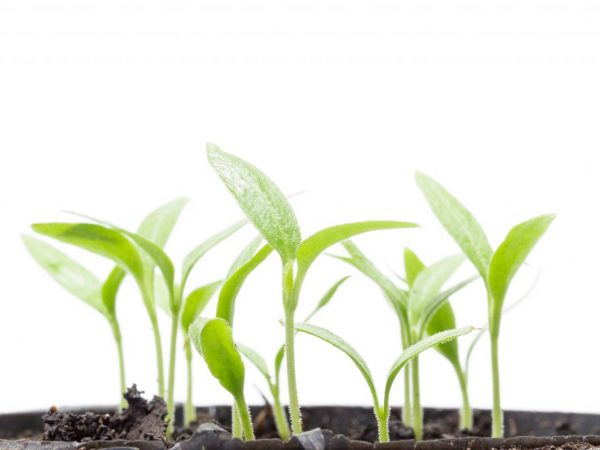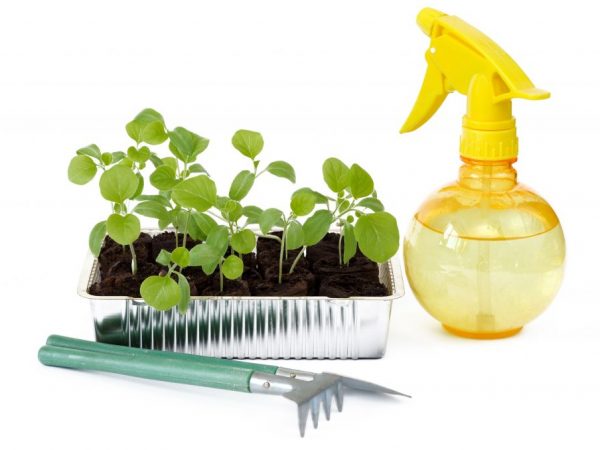Why did white spots appear on eggplant seedlings
When growing eggplant, the grower may face difficulties in caring for this vegetable crop. A common problem is white spots on eggplant seedlings. Such signs can be the result of improper care or infection with garden diseases and pests.

Why did white spots appear on eggplant seedlings
Causes of white spots
Spots on the leaves of eggplant seedlings appear for various reasons. Often, such signs are the result of errors in plant care. Unnatural light formation on foliage can occur due to the activity of the sun or improper placement of the ultraviolet lamp.
Another reason is improper crop feeding. It is important that light formations can be the result of both a lack of nutrients and their excess. The health of the plant is also influenced by the temperature of the water (it can be cold) and the temperature regime of keeping the plants.
It will be more difficult to cope with the problem if diseases are the cause of the white formations on the leaves. You can identify the infection by the following signs:
- With powdery mildew, the infected areas of the foliage are covered with a white film, which gradually grows, passing to the stem.
- White spot is characterized by the appearance of white formations with a dark border.
- Phomosis (dry rot) is characterized by the appearance of small white formations with dark blotches.
Damage to the plant by pests is also a common cause. Whiteflies, aphids, spider mites and thrips can be dangerous.
If white spots have already appeared on the eggplant, it is important to assess the degree of damage to the plant. When only one leaf is affected in seedlings, it can be removed. But if the whole sprout is damaged, the whole plant can be removed. Time is limited in treating white spot. It is important to isolate diseased seedlings before the fungus has infected other plants. And the sooner this is done, the greater the chances of saving the culture.
How to get rid of the problem
White spots on the leaves of eggplant can appear for various reasons, determining which measures can be taken. So, if light formations on the foliage are the result of sunburn, you will have to shade the plant with improvised materials (stretch fabric, use a newspaper, etc.). And if the cause was garden diseases and pests, you will have to use personal therapy with specialized or folk remedies.
The appearance of light formations requires decisive action from the gardener. The first thing to do is inspect the plant for damage. A magnifying glass should be used. There is a risk that the foliage has turned white due to pests.
If there are no signs of pests, it should be remembered whether fertilizers were used with mineral formulations.If yes, then it is important to rinse the foliage of the seedlings with a weak solution of potassium permanganate, and diseased leaves with a solution of citric acid and copper sulfate.

Eggplants need care and timely feeding
Correction of errors in care
If white spots appear on eggplant seedlings, this may indicate mistakes made in the daily care of the plant. It will be possible to eliminate the problem only if the quality of agrotechnical measures is restored. It will be possible to get rid of the problems that have arisen if:
- Shade the plant or move it to a dark place. Such actions are necessary if transparent or white formations appeared due to the activity of the sun.
- Normalize the temperature regime. The problem is inherent in regions with a changeable climate. The construction of a mini greenhouse or greenhouse will be required.
- Monitor the temperature of the water for irrigation. It shouldn't be cold. The most effective use of water, with a temperature of 22-23 ° C.
- Get rid of excess moisture (when growing crops in a greenhouse) by airing.
- Treat the plant with a weak solution of potassium permanganate. This method is effective when plantings are oversaturated with dressings.
The appearance of formations on foliage due to a lack of potassium is compensated by the introduction of feeding with an increased content of this element. Specialty formulations, ground banana peel, or wood ash can be used.
You can also use a folk remedy. The resulting stains can be removed by spraying the infected culture with a serum solution (100 ml of the product is diluted with 1 liter of water).
Treatment of spots in diseases
If white spots appear on the eggplant seedlings due to infection with garden diseases, proceed as follows:
- Powdery mildew. A 0.5% solution of soda ash is used (1 g of substance per 1 liter of water). Spraying is carried out once a week for a month. Another option is to use the specialized drug Fundazol.
- White spot. Isolation of the diseased plant, drying of the soil and treatment with fungicides ("Fanos", etc.) is required. In the absence of a result, the infected part of the plantings can be removed.
- Dry rot. The disease is not treatable. Infected plantings should be removed.
With proper treatment, the likelihood of recovery of the vegetable crop is high. It is possible not only to return the natural color of the seedling foliage, but also to preserve its growth and development, which will affect the amount of the future harvest.
Treatment of pest stains
If white spots appear on the surface of the eggplant leaves, the cause of this phenomenon may be the parasitic action of pests. Some of their varieties can be viewed through a magnifying glass, but more often they are not visible to the human eye. As a result, when feeding on the sap of the plant, the leaves become dry. Transparent formations can also form.
When white spots appear on the eggplant foliage, you can apply universal specialized preparations:
- Aktarra;
- Actellik;
- Confidor;
- Tanrek.
Most of the products available on the shelves of specialty stores are sold in the form of chemical solutions and concentrates. They are used for spraying and watering pest-infected vegetable crops, taking into account the available recommendations for use.
Prevention and helpful advice
So that spots on the foliage of the plant do not bother the gardener and do not interfere with the planted culture to grow and develop, it is important when choosing seeds to pay attention to varieties resistant to garden diseases. The most popular are:
- Epic F1;
- King of the North F1;
- Gardener's dream.
Dry white spots are often a sign of inaccuracies in care, so it is important to pay attention to disinfecting the soil with a weak solution of potassium permanganate and careful watering. Even a few drops of water falling on the leaves of a plant can leave burns on them in the summer.Plants should be watered with settled water at room temperature. The plantings are poured only at the root. The frequency of activities is determined by the condition of the soil.
Special attention is paid to the preparation of the soil substrate. If the soil is suitable for the culture, and it feels good in it, this will also affect its resistance to diseases and pests. Possible problems can be avoided by mixing turf soil (3 parts), humus (2 parts) and sand (1 part). To exclude the possibility of introducing infection, the soil should be pre-calcined.
Top dressing is carried out every 2 weeks, after the formation of leaves. Sub-root dressing is used with a solution of ammonium nitrate (25 g of substance per bucket of water). Mineral formulations are only needed before flowering, and proper lighting is also important. It doesn't have to be straightforward. Daylight hours - 12 hours.
Conclusion
The leaves of the fruit crop turn white for various reasons. Such signs appear due to plant infection with garden diseases (Dry Rot, White Spot, etc.) or pests (whitefly, aphids, etc.), as well as through the fault of the gardener. It is possible to cure infected plantings by knowing the cause of the appearance of white formations. In case of problems with care, it will be necessary to normalize agrotechnical measures, in case of diseases and pests, the use of specialized means. With timely assistance to the culture, the chances of saving the planted plants are great.


